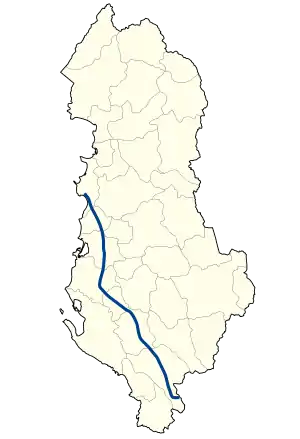SH 4 (Albania)
The SH4 highway (Albanian: Rruga Shtetërore 4) is a national highway in Albania spanning 223.29 kilometres (138.75 miles) across the counties of Durrës, Fier, Gjirokastër and Tirana. As it connects the country's second largest city Durrës to Greece, the highway represents a significant north–south transportation corridor in Albania and an essential part of the Adriatic–Ionian motorway and Pan-European Corridor VIII.
 | |
|---|---|
| Rruga shtetërore SH4 | |
 Map of the Rruga Shtetërore 4 (SH4) mainline denoted in blue in Albania | |
| Route information | |
| Part of | |
| Maintained by the Autoriteti Rrugor Shqiptar | |
| Length | 223.29 km (138.75 mi) |
| Major junctions | |
| North end | |
| South end | |
| Location | |
| Country | Albania |
| Counties | Durrës, Fier, Gjirokastër, Tirana |
| Major cities | Durrës, Fier Gjirokastër, Kavajë, Libohovë, Lushnjë, Rrogozhinë, Tepelenë |
| Highway system | |
Description
The Rruga Shtetërore 4 (SH4) constitutes the southern section of the north–south transportation corridor in Albania.[1][2] It connects the country's second largest city of Durrës on the Adriatic Sea to the country of Greece at the Kakavijë border crossing. Part of the road network of Albania, the highway is a portion of the European route E853 Kakavijë–Ioannina, and the Pan-European Corridor VIII Durrës–Skopje–Sofia–Varna.[3][4][5] Combined with the Rruga Shtetërore 1 (SH1), the northern section of the north–south corridor, the highway will form a major segment of the proposed Adriatic–Ionian motorway.[2][4]
Route
The Rruga Shtetërore 4 (SH4) consists of two traffic lanes and an emergency lane in each driving direction separated by a central reservation along most of its length.[6] There are a number of rest areas along the highway providing various types of services, ranging from simple parking spaces to filling stations.[6] The highway spans 223.29 kilometres (138.75 miles) between the city of Durrës in Durrës County across Rrogozhinë in Tirana County, Fier in Fier County, Tepelenë in Gjirokastër County and the Kakavia border crossing to Greece.
References
- "Rrjeti Rrugor KombëtarInventari sipas numrit të Rrugeve" (PDF) (in Albanian). Ministria e Infrastrukturës dhe Energjisë. Archived from the original (PDF) on 11 July 2019. Retrieved 30 August 2020.
- Mazrekaj, Ramadan (July 2015). "Albania – as the Bridge of Routes and Transport Corridors between the Adriatic Sea and Black Sea" (PDF). p. 2. Archived from the original (PDF) on 31 August 2020. Retrieved 31 August 2020.
- "European Agreement on Main International Traffic Arteries (AGR)" (PDF). United Nations Economic Commission for Europe (UNECE). 1 November 2016. Archived from the original (PDF) on 3 August 2020. Retrieved 30 August 2020.
- "Dokumentat e procedurës Konkurruese për dhënien me Koncesion/Partneritet publik privat për Projektimin, Ndërtimin, Financimin, Operimin, Mirëmbajtjen, Rehabilitimin dhe Transferimin e Segmentit Rrugor Milot-Thumanë-Kashar-Luzi i Vogël-Fier" (PDF) (in Albanian). Ministria e Infrastrukturës dhe Energjisë. pp. 5–7. Archived from the original (PDF) on 30 August 2020. Retrieved 30 August 2020.
- "Transport : launch of the Italy-Turkey pan-European Corridor through Albania, Bulgaria, Former Yugoslav Republic of Macedonia and Greece". Brussels: European Commission (EC). 9 September 2002. Archived from the original on 30 August 2020. Retrieved 30 August 2020.
- "Feasibility Study for the Adriatic-Ionian Road Corridor (Route 1 and Route 2) Montenegro and Albania WB14-REG-TRA-01" (PDF). Ministria e Infrastrukturës dhe Energjisë. June 2020. pp. 90, 141. Archived from the original (PDF) on 31 August 2020. Retrieved 31 August 2020.
External links
 Media related to Rruga Shtetërore 4 at Wikimedia Commons
Media related to Rruga Shtetërore 4 at Wikimedia Commons